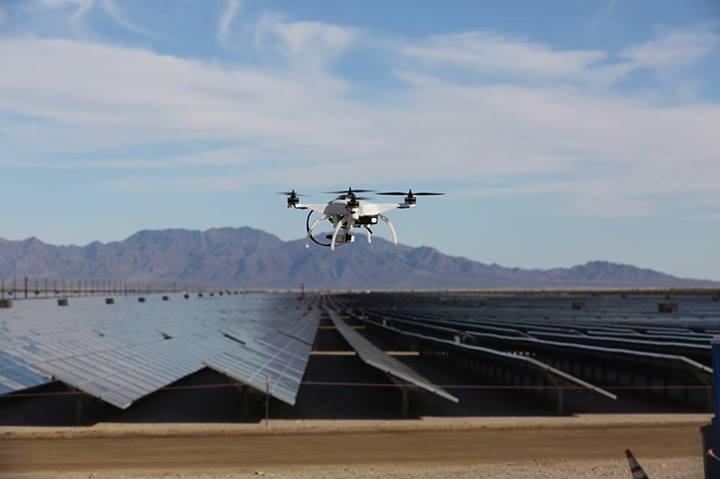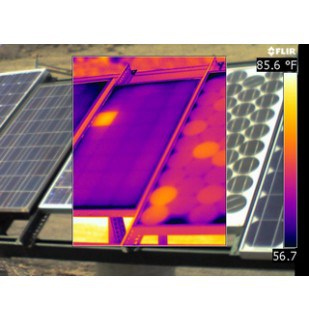
Very interesting piece from Engineering.com about Skycatch, which uses a Pixhakw-based custom quadcopter for solar panel inspection:
Like many new technologies, Unmanned Aerial Vehicles (UAVs) started with military applications and gradually found their way into civilian life. With support from investors such as Google, a new company called Skycatch has developed a UAV that’s used for remote monitoring and inspecting construction sites, mining operations, and farms. Now Skycatch is getting into the solar array inspection business. It will soon begin testing its technology on PV farms built by industry giants SolarCity and First Solar.
Infrared Signatures Show Defective Panels
Photovoltaic panels emit a certain amount of heat, and it turns out that defective panels give off more heat than functioning panels. The difference in temperature can be easily detected using an infrared thermal imaging camera, as shown in the image below. A quick flyover by a UAV armed with an IR camera can identify malfunctioning panels quickly and inexpensively, allowing operators to replace the panels and keep the solar farm running at peak efficiency. You won’t see these flying over residential rooftop arrays; it’s only cost-effective for utility-scale solar farms.
The Vehicle and Base Unit
The Skycatch quadcopter weighs about 2.3kg (5 pounds) and is armed with a variety of sensors, depending on the application. For solar farm inspection, it uses a Tau IR camera, which adds only 70 grams to the overall weight. Autonomous navigation employs GPS and sonar, and the quadcopter can also be operated by remote control when necessary. It can fly 80km/hr (50 MPH), reach altitudes of 120 meters (400 ft), and maintain its position under windy conditions; its drift is about 30 cm (1 foot) in 40 km/hr (25 MPH) winds.
The copter returns to its base unit to dump its data and have its battery replaced. Once the quadcopter is docked, the base unit’s robotic arm swaps out the weak battery and replaces it with a fresh one from a carousel. Each battery pack includes 15 GB of storage; its data is then uploaded to cloud-based storage using the base unit’s WiFi connection.
Will It Fly?
Not the drone, of course - I know that flies. But will UAV inspection of PV farms make a significant economic impact on solar energy production? The National Renewable Energy Laboratory (NREL) estimates that PV panels suffer a failure rate of less than 1% per year, which doesn’t seem like much, but it adds up over time. Given the relatively low cost of UAVs, it’s probably worthwhile to have aerial robotic inspectors doing a flyover of a solar farm once in a while.
Images courtesy of Skycatch.

Comments
Hot Panels have more loss. ;-)
That was my initial thought as well. Crashes happen!
Panels are pretty tough. Designed to have a big hail stone land on it. Be bad from height, but I think pretty low risk from lower heights.
I've heard of companies in Asia making steps towards doing this as well so I imagine it is a real use-case for autonomous copters. I just hope the copter doesn't land on the panels!